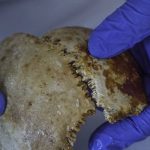An international team of archaeologists returned to the site of the sinking of the famous wreckage after more than 100 years, where an ancient computer was found – the Antikythera mechanism. It turned out that the wreck hides more unusual secrets.
The Greek-American team first made a three-dimensional map of the seabed and then proceeded to extract the ship’s cargo. As expected, much of the items the unit was carrying are still buried in the mud. Found, among others more than a meter long lead anchors, but the most astonishing was the large area over which the load is spread. Objects cover 300 meters of the bottom, which indicates that the vessel carrying it could have been as long as 50 meters. It is the largest ancient shipwreck ever discovered. It’s the Titanic of the Ancient World, says Brendan Foley of the Woods Hole Oceanographic Institution.
From the seabed, among others, a beautifully decorated mug, a fragment of a decorated leg from the bed, a 2-meter long bronze spear. It is too big and heavy to be used as a weapon. According to Foley, the spear was part of a life-size statue. Perhaps it depicted Athena. Foley recalls that in 1901 the sponge hunters who discovered the wreck also found four large marble horses. So they could have been part of a sculpture representing a warrior (Athena?) On a chariot pulled by four horses.
The Antikythera wreckage dates back to 70-60 BCE. The ship was probably carrying luxury goods from Asia Minor to Rome. The island of Antikythera is located in the middle of this ancient trade route. The unit probably sank as a result of a violent storm that threw it on the coastal rocks.
The ship is at a depth of over 40 meters. It is too much to work safely there in ordinary overalls. For the needs of archaeological work, a new diving system was developed, which allowed them to stay underwater for up to 3 hours. Archaeological work will continue next year.







